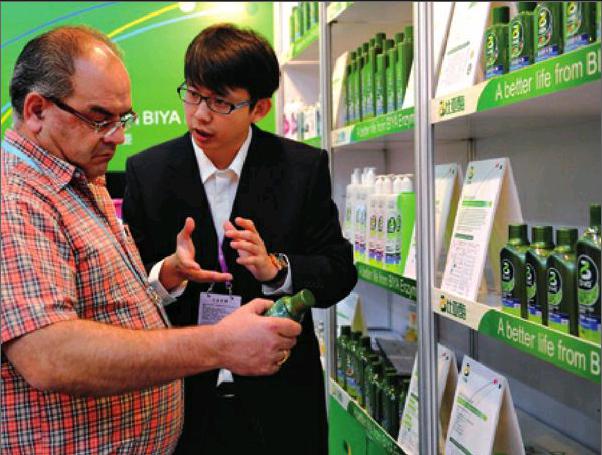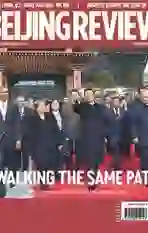Falling Figures,Rising Spirits
2014-12-19ByDengYaqing
By+Deng+Yaqing

The 116th Canton Fair, a biannual international trade fair, raised alarms again about Chinas foreign trade development by registering a decline of both transactions and buyers during its three phases lasting from October 15 to November 4.
As Liu Jianjun, Director of China Foreign Trade Center, introduced, a total of 186,104 buyers from 211 countries and regions attended the autumn session. Attendance dropped 1.07 percent from the spring session of 2014; its volume of transaction reached 179.2 billion yuan ($29.16 billion), a decrease of 6.1 percent from the spring session. In addition, exports toward Chinas major trade partners including the European Union, the United States, Middle East, Brazil, Russia, India, South Africa and Japan witnessed a decline.
While Liu suggested that the current foreign trade situation should not be optimistic, some experts believe Chinas foreign trade sector has taken on a “new normal”—slow but steady growth. At the same time, the prosperity of cross-border e-commerce and comprehensive foreign trade platforms have posed a new challenge for traditional trade patterns.
“Enterprises should calm down and take the new normal objectively. For example, despite the fact that Chinas export of light industrial products has maintained two-digit growth in the past few years, it has lost the market foundation to experience dramatic expansion due to the rising factor cost in China and the limited market potential overseas,” said Li Wenfeng, Deputy Director of China Chamber of Commerce for Import and Export of Light Industrial Products and Arts-Crafts.
Strong confidence
Although the Canton Fair experienced a double plummet of transactions and buyers, more than 90 percent of exhibitors chose to apply for booths this autumn, indicating that most Chinese foreign trade enterprises still maintain strong belief in the long-term development, said Liu.
According to Zhu Dan, vice General Manager of Overseas Household Appliance Production Line of Hisense International Co. Ltd., Hisense exported 3.64 million televisions in the first half of this year, up 22.2 percent year on year, and exported 3.01 million refrigerators during the same period, up 18.8 percent. “Under the adverse international economic circumstances, Chinesemade products will have a better chance of success because of their high-quality performance and relatively low cost,” said Zhu.
vice Minister of Commerce Fang Aiqing noted that an array of policies has been released to reduce the burden on enterprises and vitalize the market, and more efforts will be made to facilitate the sustainable and stable growth of foreign trade.
yu yi, Deputy Director of China Chamber of Commerce of Metals, Minerals& Chemicals Importers & Exporters noted, in the current precarious international economic environment, the more proprietary intellectual property rights Chinese brands have, the less they are affected by the adversity.
Huo Jianguo, President of Chinese Academy of International Trade and Economic Cooperation, recommended that domestic enterprises get accustomed to the new normal by undergoing transformation, upgrading, enhancing quality and efficiency, and complying with the new trends featuring big data and e-commerce.
“Only when the competitiveness of Chinese enterprises is improved can China boost its overall strength of foreign trade,” said Huo.
New features
Statistics from the Ministry of Commerce, ordinary trade characterized by the export of Chinese brands surpassed that of processing trade in 2011 and has been gaining ground. In other words, as the corporate transformation and upgrading as well as the gradient transfer of industrial chain keep moving forward, processing trade featuring original equipment manufacturer (OEM) is playing a dwindling role.
Take mechanical and electrical exports for example. In the first eight months of this year, their processing export volume fell 0.9 percent, while ordinary export volume climbed 12.4 percent.
“The negative growth of processing trade reflects that OEM orders are fleeing from China to other countries, and China is amidst a transitional period from low-end production featuring processing trade to Chinese-brand-driven ordinary trade,” said Shi yonghong, Deputy Director of China Chamber of Commerce for Import and Export of Machinery and Electronic Products.
In the past, exchange rate fluctuations always put foreign trade enterprises on tenterhooks. These days, things have changed. As a survey published by China Chamber of Commerce of Metals, Minerals & Chemicals Importers & Exporters conveys, the major problems exporters in the trade now face are constantly increasing cost pressure, political unrest in some parts of the international market, the unreleased dividends of trade facilitation policies and the aggravating international trade frictions.
As the two-way fluctuation of renminbi has become quite common, enterprises tend to hedge exchange rate risks by purchasing financial derivatives, according to the report. Foreign trade enterprises have become increas- ingly aware of the fact that they can have a louder voice in the international competition only through transformation, upgrading, brand effect and technological innovation, rather than low price and the depreciation of renminbi.
Zhang Qingfu, Market Director of the Middle East and African Branch of Haier Group, noted that enterprises no longer fix their eyes on the small fluctuations of production cost, but rather focus on creating value by exploring consumer demands, which can offset the negative impact of any cost fluctuations.
In addition, as European countries and the United States have begun to pursue the remanufacturing strategy, trade protectionism is surging in the overseas market and is showing a transfer from high-tech commodities to products with proprietary intellectual property rights.
Cao yunduan, Marketing Manager of Trina Solar, a Changzhou-based photovoltaic manufacturer, suggested that since Chinese-made solar power generation equipment be widely coveted by many countries in the world, dealing with trade frictions is a major issue on the minds of domestic solar enterprises.
Kong Lingye, General Manager of Foshan-based Mona Lisa Industrial Co. Ltd., said the industry of metals, minerals and chemicals is also severely afflicted by trade frictions. Due to the anti-dumping investigation on Chinesemade ceramic tiles initiated by Brazil, Chinas exports of ceramic tiles into Brazil have plummeted from more than $20 million to less than $1 million a year.
The surging trade frictions against Chinese products in combination with the rising production and operation cost in China have pushed a great many Chinese enterprises to establish overseas production bases and marketing networks. Beyond that, their overseas layout can help them gain access to first-hand market information, facilitate product development and orientation, and strengthen their presence in the overseas market.
As a matter of fact, some competent foreign trade enterprises have begun to put their global industrial chains in place, ranging from raw material purchase, product design, brand management and global marketing. Without a doubt, its a positive attempt to avoid risks by driving commodity export with capital export.
